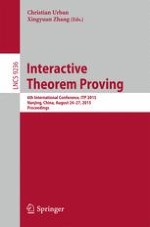2015 | Buch
Interactive Theorem Proving
6th International Conference, ITP 2015, Nanjing, China, August 24-27, 2015, Proceedings
herausgegeben von: Christian Urban, Xingyuan Zhang
Verlag: Springer International Publishing
Buchreihe : Lecture Notes in Computer Science
